AUCTORES
Globalize your Research
Research article | DOI: https://doi.org/10.31579/2693-4779/118
1 IAE, 175-28, Goan-ro 51 beon-gil, Baegam-myeon, Cheoin-gu, Yongin-si, Gyeonggi-do, 17180, Korea
*Corresponding Author: Dong-Chan Lee
Citation: Dong-Chan Lee. (2022) Biomechanical Measurement Considerations of Joint Segmental Range of Motion using 3-Dimensional Motion Analysis. Clinical Research and Clinical Trials. 6(3) ; DOI :10.31579/2693-4779/118
Copyright: © 2022 Dong-Chan Lee, This is an open access article distributed under the Creative Commons Attribution License, which permits unrestricted use, distribution, and reproduction in any medium, provided the original work is properly cited.
Received: 14 November 2022 | Accepted: 21 November 2022 | Published: 30 November 2022
Keywords: motion analysis; joint torque; range of motion; biomechanical measurements
This paper suggests a biomechanical analysis of the joint motion of the arm based on the 3-dimensional motion analysis technique in the steering wheel action. The three-dimensional motion trajectory of the arm is obtained using the motion capture system, and the inverse kinematic analysis and inverse dynamics analysis are performed on the musculoskeletal model of the arm using this result. By doing this, the displacement of the arm joint and the magnitude of the joint torque are calculated. The rotational motion of each joint occurs simultaneously and in the joint motion, it can be confirmed that pronation-supination of the elbow joint, adduction-abduction of the shoulder joint, flexion-extension and flexion-extension of the wrist joint are the main movement parameters.
Using this biomechanical motion analysis of joint segmental range of motion, it can be extended to analyze the behavior of passengers indoors in the autonomous vehicles.
In the autonomous vehicles, it is necessary for the driver to analyze the driver's intentional/unintentional behavior and perception according to changes in traffic conditions. Most of the steering systems currently used have a function of assisting the power, so hydraulic or electric driving force is used to enable the driver to smoothly operate the steering wheel with little force. It provides convenience features. As vehicles become more intelligent and electronic, the recently developed steering system has evolved to a level that not only provides a function of assisting steering power, but also performs active functions such as controlling steering torque or changing lanes by judging by itself according to driving conditions. is becoming These include drive-by-wire systems, active steering systems, and lane keeping systems. However, as a future car, autonomous cars focus on providing convenience to occupants, so the driver can use the steering system depending on the driving situation. should be able to provide Therefore, it is necessary to examine the behavior of the driver's upper body in order to understand the driver's intention for the driving situation. Accordingly, it is necessary to quantify and analyze the range of motion for each joint segment of the driver's upper body.
The steering system transmits steering input to the wheels and at the same time feeds back the tire traction that changes depending on the driving situation to the driver. It is a man-machine system. Until now, research on the steering system has mainly focused on hardware or logic to control it, and the driver's behavior has not received much attention. However, in order for the intelligent steering system to have optimal performance, an approach that connects the driver to the hardware of the steering system is required. From this perspective, this study aims to understand the characteristics of the driver's movement by performing a biomechanical analysis of the driver's arm joint motion in the steering motion as the simple example.
In order to interpret the movement of the musculoskeletal system of driver, it is essential to understand the muscle movement that causes the joint movement between bones. Delp [1] defined muscle-tendon parameter values through analysis of young cadavers, and developed a human motion analysis program based on this. Garner and Pandy et al. [2,3] studied 26 major upper body muscles and movements through an optimization technique based on maximum muscle force, muscle length, and tendon length in an isometric state. Manal and Buchanan [4] developed a numerical optimization technique for tendon length under the assumption that the change in muscle length is greater than the change in tendon length. A biomechanical analysis of steering motion was performed using a 7 DOF arm motion model [5~8]. Through the musculoskeletal model of the arm connected to the steering device, the joint torque applied to the shoulder, elbow, and wrist during steering motion was theoretically calculated. Recently, motion analysis techniques, which are rapidly developing in terms of measurement equipment, signal processing technology, and biomechanical modeling, enable reliable interpretation of the musculoskeletal system movement of the human body.
By attaching a marker that reflects light to the human body, we are recording continuous motion using a motion capture camera, obtaining the three-dimensional trajectory of each part of the human body through image processing, and inputting the result into the musculoskeletal model of the human body joint. It allows to calculate the kinematic behavior of the muscle and the muscle force required for it. This is to analyzes the range of motion (ROM) and motion characteristics of the driver's shoulder, elbow and wrist joints during steering operation using motion analysis technique. Using this interconnected model between the musculoskeletal model and motion capture model of human body, the torque transmitted on each joint during steering operation is estimated. In addition, this study can be to present a basis for analyzing the sensitivity of joint motion according to the change of the relative position and angle of the driver's motion and the steering system with respect to the driver's seat. This paper is to introduce a general and physically intuitive system of the indoor occupant representation of autonomous vehicle which may be used qualitatively and quantitatively. Contrary to the simplistic situation in Fig. 1 given the complexities of the human actions indoor of autonomous vehicle, we would need several quantities for its complete description. In a multi-dimensional space, such quantities can be represented as a point which characterizes the indoor actions. Different indoor actions are represented by different points and the evolution of an action can be characterized by a locus of points in that space. From a dynamic systems point of view, a complete set of “state variables” uniquely describe a system. For example, the joint angle and the joint velocity constitute the state variables of multi-bodies and can completely represent its motion. Although the level of our current knowledge does not permit us to search for the complete set of state variables of the complex dynamics called the human actions, we nevertheless extract some measurable, communicable and meaningful action descriptors to describe the occupant actions. These occupant action descriptors available in the indoor of autonomous vehicle may reflect the changes in action pattern in response to some externally controllable factor or parameter.
The schematic configuration of the experimental device for motion analysis is shown in Fig. 1, and the driver's seat simulator for a passenger car used in the experiment is manufactured as shown in Fig. 2. The driver's seat can change the front and rear position with respect to the reference point and the angle of inclination of the backrest, and the angle and height of the steering wheel can be adjusted. In order to simulate the steering reaction force of the steering wheel, the servomotor connected to the steering shaft generates the steering reaction force as a function of the steering angle. The magnitude of steering reaction force assumes the torque required to steer the hydraulic power handle for a general passenger car. Steering torque and rotation angle are measured by a torque meter and rotational displacement sensor. For motion analysis, a marker is attached to the driver's body, and the movement of the marker is tracked using four motion capture cameras. The trajectory of marker is converted into three-dimensional data using real-time signal processing software. The rotation angle and joint torque of the shoulder, elbow, and wrist joints are calculated using the musculoskeletal system modeling software of the human body.
For steering motion analysis, there should be an integrated model in which the driver's musculoskeletal model and the steering system's mechanical system are linked. Since the steering motion is mainly generated by the movement of arm joint, it is assumed that the upper body is fixed to the seat and only the arm part from the shoulder to the hand is considered. As the motion of arm model is shown in Fig. 3, it consists of the upper arm (between the shoulder and the elbow), the forearm (between the elbow and the wrist) and the hand. The movement of the upper arm is three degrees of freedom: Flexion-Extension, Abduction-Adduction, External Rotation-Internal Rotation at the shoulder joint, and the movement of forearm is at the elbow joint. Two degrees of freedom for flexion-extension, pronation-supination, and the hand has 2 degrees of freedom for flexion-extension and radial deviation-ulnar deviation at the wrist joint. It was assumed to have a total 7 degrees of freedom. [5~8]
In order to obtain the 3-dimensional relation between the arm posture and the non-linear steering response in Fig. 4, the joint torques and angles should be known. Hence, a 3-dimensional model of the human posture needs to be developed to determine the joint angles for different steering angular positions, and finally to compute the joint torques. The following assumptions are considered for the human body model:
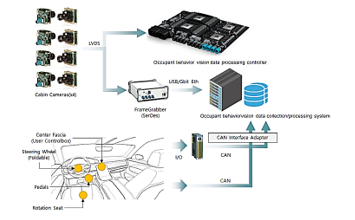
Figure 1: Schematics for driver’s steering motion analysis
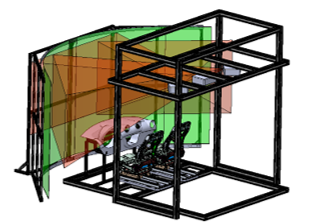
Figure 2: Experimental steering simulator

Figure 3: Arm joint motion

Figure 4: Driver-steering system interactive model [9]
Motion analysis calculates the angle at the joint center using the position information of marker measured in the motion analysis experiment, and calculates the angular velocity and angular acceleration. Then, after constructing the equation of motion using multi-body dynamics analysis software, the joint moment is calculated from the angular acceleration information of the three joints, and the change in the attachment position of the muscle and the moment arm are calculated. The calculated joint moment at each time step can be composed of a passive joint moment component generated from ligaments and cartilage in the joint and an active joint moment component due to muscle strength generated by contraction of the arm muscles. The passive joint moment is greatly affected by the subject's anatomical shape, the stiffness and shape of the joint soft tissues (ligaments, cartilage, etc.), and the attachment position. The empirical formula was used as suggested in ref. [10]. A quasi-static optimization formula is implemented to distribute the active joint moment to the arm muscles.[11] In the optimization formula, the lower extremity muscle strength becomes a variable, the physiological maximum strength of each muscle is limited [12], the constraint conditions are corrected so that the moment at which the muscle strength occurs matches the active joint moment calculated in the dynamic analysis. The objective function is the sum of the three powers of the muscle stress divided the muscle load by the muscle cross-sectional area.[11]
In this experiment, the position where the driver grips the steering wheel is assumed to be the 2 o'clock and 10 o'clock positions of the steering wheel. The driver rotates 120 degrees counterclockwise from the initial position at a rotation speed of 60 deg/s, then returns to the initial position, and then rotates 120 degrees clockwise again. At this time, make sure your hand does not miss the handle. The steering reaction force of the steering wheel is given by measuring the steering reaction force generated when a typical passenger vehicle changes lanes at a speed of 80 km/h, and as shown in Fig. 5, the actually measured steering torques as a function of the steering angle are compared with the simulated ones. It can be seen that the magnitude of torque and the hysteresis characteristics are being simulated. Since the movements of the left and right arms are symmetrical to each other during steering, motion analysis is performed only on the right arm. The rotation angle of each joint is a value measured based on an angle of 0 degrees in an anatomical position of the human body [13].
Chaffin et al. [13] are individually measured the maximum range of motion (ROM: Range Of Motion) for each joint motion of human body. As shown in Fig. 6~8, the results measured by Chaffin et al. are indicated together with the measured results and we analyze the movement of shoulder joint of the right arm. First of all, in the flexion-extension movement, when the handle is rotated clockwise, the upper arm contacts the flank and can no longer extend. When the handle is rotated counterclockwise, the flexion up to 90° increases almost linearly to about 30°and then maintains a constant value for handle angles beyond this. In the adduction-abduction movement, the adduction gradually increases to about 20° until the handle rotation angle is 90° counterclockwise, and when the handle rotation angle becomes greater than 90°, the abduction angle increases rapidly. When the handle is rotated clockwise, the adduction angle is small but continues to increase at a constant rate. It can be seen that the internal rotation-external rotation movement changes symmetrically regardless of the rotation direction of the handle. Internal rotation approaches the maximum range of motion, called the limit of joint motion, when the handle rotation angle reaches 120°. In the movement of elbow joint, flexion-extension has a small displacement of about 10° to 15° with respect to the entire angle of the handle. However, the pronation-supination movement of elbow joint is relatively large and the movement is the largest in the elbow joint. In particular, when the handle is rotated counterclockwise by 90°, the pronation angle approaches the maximum range of motion. When the handle is rotated clockwise, the pronation angle decreases, the handle angle becomes 0 at about 70° and then supination occurs. In flexion-extension of the wrist joint, when the handle is rotated counterclockwise, flexion or extension hardly occurs and when the handle is rotated clockwise, slight extension occurs. In the case of radial deviation-ulnar deviation movement, when the handle is rotated counterclockwise, radial deviation occurs up to the maximum range of motion and when the handle is rotated clockwise, radial deviation-ulnar deviation hardly occurs.
In order to calculate the torque generated at each joint when the steering wheel is rotated using the arm movement information obtained through the motion capture system, the driver-steer system linkage model was constructed as shown in Fig. 4 using multi-body dynamics S/W. The driver's arm shown in Fig. 3. is assumed to have 7 degrees of freedom and the hand is fixed to the handle. The steering system consists of a steering wheel and a steering shaft. The steering shaft is connected to the vehicle body and a universal joint and the steering wheel is connected by a cylindrical joint capable of axial translation and rotation with respect to the steering shaft. A steering reaction force is generated as a function of the rotational displacement. When the handle and the steering shaft are mechanically constrained in this way, the handle can be translated in the longitudinal direction of the steering shaft and the handle and the steering shaft combination can be rotated in two directions by the universal joint connecting the steering shaft and the vehicle. The actual steering system has only one rotational degree of freedom about the steering shaft. The three-dimensional trajectory (position and direction) of the hand measured by the motion capture system has a slight difference compared to the actual trajectory due to errors in measurement and signal processing. However, since the hand must move integrally with the handle, the hand cannot follow the circular motion trajectory of the handle due to an error in the trajectory of the hand. The degree of freedom is added to the handle so that the handle can mechanically accommodate the error of the hand movement trajectory. Even if the handle has surplus degrees of freedom, the movement of the handle is driven by the hand movement measured by the motion capture system, so there is no big difference from the actual movement.
A constant torque of 70N-m was generated from the servomotor connected to the steering shaft, and the experimenter was asked to turn the handle as slowly as possible assuming a static state. The driver's posture refers to the SAE standard [14], and the relative position and angle of the steering wheel and the steering factor are determined by the steering angle (θ), the horizontal position of the steering wheel (L), the vertical position of the steering wheel (H) and the upper body inclination angle (ψ). With reference to the driving posture of the experimenter, the values of the design variables are set as shown in Table 1. The joint torque generated in the shoulder, elbow, and wrist joints calculated using the driver-steer system model is shown in Fig. 9 ~ Fig. 15. In the analysis results, it can be seen that the joint torque has a close relationship with the steering wheel rotation angle. It shows that the direction in which the joint torque acts is different depending on the angle of rotation of the handle and the action of the joint torque is switched. The maximum value of the torque acting on each joint is about 40N-m, and the maximum value occurs in the neutral position when the handle is not turned (flexion-extension of the shoulder, external rotation-induction-abduction; pronation-supination of the elbow) or at a certain rotation angle of the handle.
| Parameters | Min. | Nominal | Max. |
| Steering wheel tilt angle(θ, deg) | 18 | 23 | 28 |
| Horizontal steering wheel center (L, mm) | 300 | 350 | 400 |
| Vertical steering wheel center (H, mm) | 600 | 650 | 700 |
| Upper body angle(ψ,deg) | 105 | 110 | 115 |
Table 1: Steering wheel position parameters

Figure 5: A measured and simulated steering torque
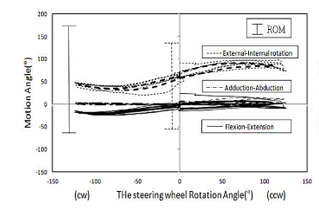
Figure 6: Shoulder joint rotation angles
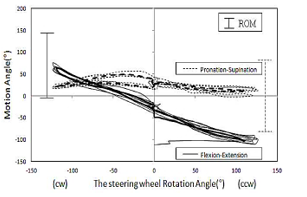
Figure 7: Elbow joint rotation angles
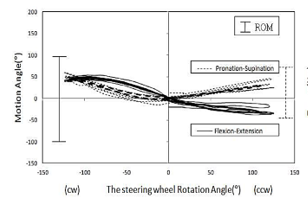
Figure 8: Wrist joint rotation angles
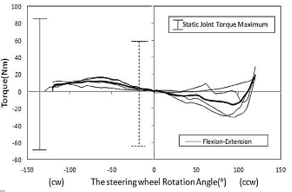
Figure 9: Joint torque of shoulder flexion-extension

Figure 10: Joint torque of shoulder external- internal rotation

Figure 11: Joint torque of shoulder adduction- abduction
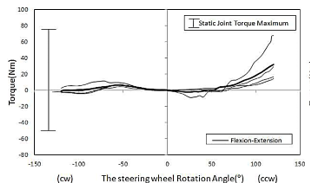
Figure 12: Joint torque of elbow flexion-extension
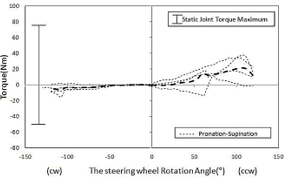
Figure 13: Joint torque of elbow pronation supination
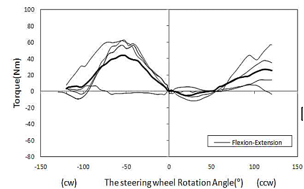
Figure 14: Joint torque of wrist flexion-extension

Figure 15: Joint torque of wrist radial-ulnar deviation
In the autonomous driving environments, key element technologies for analyzing and estimating the occupant's condition based on image-based behavioral data of the occupant were defined. Specifically, technology for estimating the occupant's gaze and extracting feature information on eye movements, facial and head movements, the upper and lower body (center of the upper body) attitude estimation technology of the occupant is defined as the main element technology. Scenarios and tasks for collecting passenger behavior data include not only events related to autonomous driving, but also scenarios of various specific purpose activities of passengers while driving, that is, actions such as manipulating a vehicle's convenience system. In addition, when a specific response action definition for an event occurring in an autonomous driving situation is defined as manual driving switching or operation of a specific control system, operation information of vehicle interior parts is also collected in the simulator at the same time.
Assuming a situation with various driving behaviors according to the preferences of the passengers of the self-driving car, the intent/unintentional behavior and cognition of the passengers are analyzed according to the changes in the traffic situation that appear at this time. Therefore, based on the scenario in Fig. 16, the simulation environment for this is implemented using the driving simulator shown in Fig. 2. In addition, it is possible to establish a safety evaluation environment to determine the ability of the occupants to respond to various unexpected situations (Take over Request, avoiding the accident site, rapid acceleration and deceleration, etc.) that may occur during autonomous driving shown in Fig. 17. A technology capable of determining the occupant's attention state can be based on quantifying the degree of mental behavior of the occupant (driver-centered) in a specific situation by utilizing eye movement information.
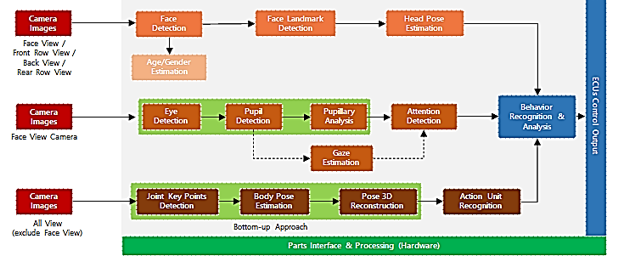
Figure 16: Element technology configuration (draft) and flow for recognizing passenger behavior

Figure 17: Example of simulator S/W Carla driving environment
Through the driver's steering motion analysis, the driver’s behavior was analyzed through the motion of the arm joint and the joint torque of the elbow joint which has a great influence on the steering motion. It can be seen that the movement of the arm joint in the steering motion is large in pronation-supination of the elbow joint, flexion-extension of the wrist joint, adduction-abduction and flexion-extension of the shoulder joint. Regarding the change in the angle of inclination of the handle, the effects of flexion-extension of the shoulder joint, flexion-extension of the elbow joint, and adduction-abduction of the shoulder joint were significant in the order of movement. Regarding the change in the horizontal position of the handle, there were significant changes in elbow joint flexion-extension, shoulder joint flexion-extension, and shoulder joint adduction-abduction. Next, with respect to the vertical position change of the handle, flexion-extension of the elbow joint, flexion-extension of the shoulder joint, and adduction-abduction of the shoulder joint were significant. In flexion-extension of the shoulder joint and adduction-abduction of the shoulder joint, the change in rotation angle was relatively large.
The technology reviewed in this study will be used to analyze the behavior of autonomous vehicle occupants. As a body posture estimation technology, HPE (Human Pose Estimation) technology is a key element technology that greatly affects the condition and behavior analysis of occupants, but estimating a person's body posture with images still seems to be a challenging research topic
This work was supported by the Technology Innovation Program (20019115) funded by the Ministry of Trade, Industry, & Energy (MOTIE, Korea)
Clearly Auctoresonline and particularly Psychology and Mental Health Care Journal is dedicated to improving health care services for individuals and populations. The editorial boards' ability to efficiently recognize and share the global importance of health literacy with a variety of stakeholders. Auctoresonline publishing platform can be used to facilitate of optimal client-based services and should be added to health care professionals' repertoire of evidence-based health care resources.

Journal of Clinical Cardiology and Cardiovascular Intervention The submission and review process was adequate. However I think that the publication total value should have been enlightened in early fases. Thank you for all.

Journal of Women Health Care and Issues By the present mail, I want to say thank to you and tour colleagues for facilitating my published article. Specially thank you for the peer review process, support from the editorial office. I appreciate positively the quality of your journal.
Journal of Clinical Research and Reports I would be very delighted to submit my testimonial regarding the reviewer board and the editorial office. The reviewer board were accurate and helpful regarding any modifications for my manuscript. And the editorial office were very helpful and supportive in contacting and monitoring with any update and offering help. It was my pleasure to contribute with your promising Journal and I am looking forward for more collaboration.

We would like to thank the Journal of Thoracic Disease and Cardiothoracic Surgery because of the services they provided us for our articles. The peer-review process was done in a very excellent time manner, and the opinions of the reviewers helped us to improve our manuscript further. The editorial office had an outstanding correspondence with us and guided us in many ways. During a hard time of the pandemic that is affecting every one of us tremendously, the editorial office helped us make everything easier for publishing scientific work. Hope for a more scientific relationship with your Journal.

The peer-review process which consisted high quality queries on the paper. I did answer six reviewers’ questions and comments before the paper was accepted. The support from the editorial office is excellent.

Journal of Neuroscience and Neurological Surgery. I had the experience of publishing a research article recently. The whole process was simple from submission to publication. The reviewers made specific and valuable recommendations and corrections that improved the quality of my publication. I strongly recommend this Journal.

Dr. Katarzyna Byczkowska My testimonial covering: "The peer review process is quick and effective. The support from the editorial office is very professional and friendly. Quality of the Clinical Cardiology and Cardiovascular Interventions is scientific and publishes ground-breaking research on cardiology that is useful for other professionals in the field.

Thank you most sincerely, with regard to the support you have given in relation to the reviewing process and the processing of my article entitled "Large Cell Neuroendocrine Carcinoma of The Prostate Gland: A Review and Update" for publication in your esteemed Journal, Journal of Cancer Research and Cellular Therapeutics". The editorial team has been very supportive.

Testimony of Journal of Clinical Otorhinolaryngology: work with your Reviews has been a educational and constructive experience. The editorial office were very helpful and supportive. It was a pleasure to contribute to your Journal.

Dr. Bernard Terkimbi Utoo, I am happy to publish my scientific work in Journal of Women Health Care and Issues (JWHCI). The manuscript submission was seamless and peer review process was top notch. I was amazed that 4 reviewers worked on the manuscript which made it a highly technical, standard and excellent quality paper. I appreciate the format and consideration for the APC as well as the speed of publication. It is my pleasure to continue with this scientific relationship with the esteem JWHCI.

This is an acknowledgment for peer reviewers, editorial board of Journal of Clinical Research and Reports. They show a lot of consideration for us as publishers for our research article “Evaluation of the different factors associated with side effects of COVID-19 vaccination on medical students, Mutah university, Al-Karak, Jordan”, in a very professional and easy way. This journal is one of outstanding medical journal.
Dear Hao Jiang, to Journal of Nutrition and Food Processing We greatly appreciate the efficient, professional and rapid processing of our paper by your team. If there is anything else we should do, please do not hesitate to let us know. On behalf of my co-authors, we would like to express our great appreciation to editor and reviewers.

As an author who has recently published in the journal "Brain and Neurological Disorders". I am delighted to provide a testimonial on the peer review process, editorial office support, and the overall quality of the journal. The peer review process at Brain and Neurological Disorders is rigorous and meticulous, ensuring that only high-quality, evidence-based research is published. The reviewers are experts in their fields, and their comments and suggestions were constructive and helped improve the quality of my manuscript. The review process was timely and efficient, with clear communication from the editorial office at each stage. The support from the editorial office was exceptional throughout the entire process. The editorial staff was responsive, professional, and always willing to help. They provided valuable guidance on formatting, structure, and ethical considerations, making the submission process seamless. Moreover, they kept me informed about the status of my manuscript and provided timely updates, which made the process less stressful. The journal Brain and Neurological Disorders is of the highest quality, with a strong focus on publishing cutting-edge research in the field of neurology. The articles published in this journal are well-researched, rigorously peer-reviewed, and written by experts in the field. The journal maintains high standards, ensuring that readers are provided with the most up-to-date and reliable information on brain and neurological disorders. In conclusion, I had a wonderful experience publishing in Brain and Neurological Disorders. The peer review process was thorough, the editorial office provided exceptional support, and the journal's quality is second to none. I would highly recommend this journal to any researcher working in the field of neurology and brain disorders.

Dear Agrippa Hilda, Journal of Neuroscience and Neurological Surgery, Editorial Coordinator, I trust this message finds you well. I want to extend my appreciation for considering my article for publication in your esteemed journal. I am pleased to provide a testimonial regarding the peer review process and the support received from your editorial office. The peer review process for my paper was carried out in a highly professional and thorough manner. The feedback and comments provided by the authors were constructive and very useful in improving the quality of the manuscript. This rigorous assessment process undoubtedly contributes to the high standards maintained by your journal.

International Journal of Clinical Case Reports and Reviews. I strongly recommend to consider submitting your work to this high-quality journal. The support and availability of the Editorial staff is outstanding and the review process was both efficient and rigorous.

Thank you very much for publishing my Research Article titled “Comparing Treatment Outcome Of Allergic Rhinitis Patients After Using Fluticasone Nasal Spray And Nasal Douching" in the Journal of Clinical Otorhinolaryngology. As Medical Professionals we are immensely benefited from study of various informative Articles and Papers published in this high quality Journal. I look forward to enriching my knowledge by regular study of the Journal and contribute my future work in the field of ENT through the Journal for use by the medical fraternity. The support from the Editorial office was excellent and very prompt. I also welcome the comments received from the readers of my Research Article.

Dear Erica Kelsey, Editorial Coordinator of Cancer Research and Cellular Therapeutics Our team is very satisfied with the processing of our paper by your journal. That was fast, efficient, rigorous, but without unnecessary complications. We appreciated the very short time between the submission of the paper and its publication on line on your site.

I am very glad to say that the peer review process is very successful and fast and support from the Editorial Office. Therefore, I would like to continue our scientific relationship for a long time. And I especially thank you for your kindly attention towards my article. Have a good day!

"We recently published an article entitled “Influence of beta-Cyclodextrins upon the Degradation of Carbofuran Derivatives under Alkaline Conditions" in the Journal of “Pesticides and Biofertilizers” to show that the cyclodextrins protect the carbamates increasing their half-life time in the presence of basic conditions This will be very helpful to understand carbofuran behaviour in the analytical, agro-environmental and food areas. We greatly appreciated the interaction with the editor and the editorial team; we were particularly well accompanied during the course of the revision process, since all various steps towards publication were short and without delay".

I would like to express my gratitude towards you process of article review and submission. I found this to be very fair and expedient. Your follow up has been excellent. I have many publications in national and international journal and your process has been one of the best so far. Keep up the great work.

We are grateful for this opportunity to provide a glowing recommendation to the Journal of Psychiatry and Psychotherapy. We found that the editorial team were very supportive, helpful, kept us abreast of timelines and over all very professional in nature. The peer review process was rigorous, efficient and constructive that really enhanced our article submission. The experience with this journal remains one of our best ever and we look forward to providing future submissions in the near future.

I am very pleased to serve as EBM of the journal, I hope many years of my experience in stem cells can help the journal from one way or another. As we know, stem cells hold great potential for regenerative medicine, which are mostly used to promote the repair response of diseased, dysfunctional or injured tissue using stem cells or their derivatives. I think Stem Cell Research and Therapeutics International is a great platform to publish and share the understanding towards the biology and translational or clinical application of stem cells.

I would like to give my testimony in the support I have got by the peer review process and to support the editorial office where they were of asset to support young author like me to be encouraged to publish their work in your respected journal and globalize and share knowledge across the globe. I really give my great gratitude to your journal and the peer review including the editorial office.

I am delighted to publish our manuscript entitled "A Perspective on Cocaine Induced Stroke - Its Mechanisms and Management" in the Journal of Neuroscience and Neurological Surgery. The peer review process, support from the editorial office, and quality of the journal are excellent. The manuscripts published are of high quality and of excellent scientific value. I recommend this journal very much to colleagues.

Dr.Tania Muñoz, My experience as researcher and author of a review article in The Journal Clinical Cardiology and Interventions has been very enriching and stimulating. The editorial team is excellent, performs its work with absolute responsibility and delivery. They are proactive, dynamic and receptive to all proposals. Supporting at all times the vast universe of authors who choose them as an option for publication. The team of review specialists, members of the editorial board, are brilliant professionals, with remarkable performance in medical research and scientific methodology. Together they form a frontline team that consolidates the JCCI as a magnificent option for the publication and review of high-level medical articles and broad collective interest. I am honored to be able to share my review article and open to receive all your comments.

“The peer review process of JPMHC is quick and effective. Authors are benefited by good and professional reviewers with huge experience in the field of psychology and mental health. The support from the editorial office is very professional. People to contact to are friendly and happy to help and assist any query authors might have. Quality of the Journal is scientific and publishes ground-breaking research on mental health that is useful for other professionals in the field”.

Dear editorial department: On behalf of our team, I hereby certify the reliability and superiority of the International Journal of Clinical Case Reports and Reviews in the peer review process, editorial support, and journal quality. Firstly, the peer review process of the International Journal of Clinical Case Reports and Reviews is rigorous, fair, transparent, fast, and of high quality. The editorial department invites experts from relevant fields as anonymous reviewers to review all submitted manuscripts. These experts have rich academic backgrounds and experience, and can accurately evaluate the academic quality, originality, and suitability of manuscripts. The editorial department is committed to ensuring the rigor of the peer review process, while also making every effort to ensure a fast review cycle to meet the needs of authors and the academic community. Secondly, the editorial team of the International Journal of Clinical Case Reports and Reviews is composed of a group of senior scholars and professionals with rich experience and professional knowledge in related fields. The editorial department is committed to assisting authors in improving their manuscripts, ensuring their academic accuracy, clarity, and completeness. Editors actively collaborate with authors, providing useful suggestions and feedback to promote the improvement and development of the manuscript. We believe that the support of the editorial department is one of the key factors in ensuring the quality of the journal. Finally, the International Journal of Clinical Case Reports and Reviews is renowned for its high- quality articles and strict academic standards. The editorial department is committed to publishing innovative and academically valuable research results to promote the development and progress of related fields. The International Journal of Clinical Case Reports and Reviews is reasonably priced and ensures excellent service and quality ratio, allowing authors to obtain high-level academic publishing opportunities in an affordable manner. I hereby solemnly declare that the International Journal of Clinical Case Reports and Reviews has a high level of credibility and superiority in terms of peer review process, editorial support, reasonable fees, and journal quality. Sincerely, Rui Tao.

Clinical Cardiology and Cardiovascular Interventions I testity the covering of the peer review process, support from the editorial office, and quality of the journal.

Clinical Cardiology and Cardiovascular Interventions, we deeply appreciate the interest shown in our work and its publication. It has been a true pleasure to collaborate with you. The peer review process, as well as the support provided by the editorial office, have been exceptional, and the quality of the journal is very high, which was a determining factor in our decision to publish with you.
The peer reviewers process is quick and effective, the supports from editorial office is excellent, the quality of journal is high. I would like to collabroate with Internatioanl journal of Clinical Case Reports and Reviews journal clinically in the future time.

Clinical Cardiology and Cardiovascular Interventions, I would like to express my sincerest gratitude for the trust placed in our team for the publication in your journal. It has been a true pleasure to collaborate with you on this project. I am pleased to inform you that both the peer review process and the attention from the editorial coordination have been excellent. Your team has worked with dedication and professionalism to ensure that your publication meets the highest standards of quality. We are confident that this collaboration will result in mutual success, and we are eager to see the fruits of this shared effort.

Dear Dr. Jessica Magne, Editorial Coordinator 0f Clinical Cardiology and Cardiovascular Interventions, I hope this message finds you well. I want to express my utmost gratitude for your excellent work and for the dedication and speed in the publication process of my article titled "Navigating Innovation: Qualitative Insights on Using Technology for Health Education in Acute Coronary Syndrome Patients." I am very satisfied with the peer review process, the support from the editorial office, and the quality of the journal. I hope we can maintain our scientific relationship in the long term.
Dear Monica Gissare, - Editorial Coordinator of Nutrition and Food Processing. ¨My testimony with you is truly professional, with a positive response regarding the follow-up of the article and its review, you took into account my qualities and the importance of the topic¨.

Dear Dr. Jessica Magne, Editorial Coordinator 0f Clinical Cardiology and Cardiovascular Interventions, The review process for the article “The Handling of Anti-aggregants and Anticoagulants in the Oncologic Heart Patient Submitted to Surgery” was extremely rigorous and detailed. From the initial submission to the final acceptance, the editorial team at the “Journal of Clinical Cardiology and Cardiovascular Interventions” demonstrated a high level of professionalism and dedication. The reviewers provided constructive and detailed feedback, which was essential for improving the quality of our work. Communication was always clear and efficient, ensuring that all our questions were promptly addressed. The quality of the “Journal of Clinical Cardiology and Cardiovascular Interventions” is undeniable. It is a peer-reviewed, open-access publication dedicated exclusively to disseminating high-quality research in the field of clinical cardiology and cardiovascular interventions. The journal's impact factor is currently under evaluation, and it is indexed in reputable databases, which further reinforces its credibility and relevance in the scientific field. I highly recommend this journal to researchers looking for a reputable platform to publish their studies.

Dear Editorial Coordinator of the Journal of Nutrition and Food Processing! "I would like to thank the Journal of Nutrition and Food Processing for including and publishing my article. The peer review process was very quick, movement and precise. The Editorial Board has done an extremely conscientious job with much help, valuable comments and advices. I find the journal very valuable from a professional point of view, thank you very much for allowing me to be part of it and I would like to participate in the future!”

Dealing with The Journal of Neurology and Neurological Surgery was very smooth and comprehensive. The office staff took time to address my needs and the response from editors and the office was prompt and fair. I certainly hope to publish with this journal again.Their professionalism is apparent and more than satisfactory. Susan Weiner

My Testimonial Covering as fellowing: Lin-Show Chin. The peer reviewers process is quick and effective, the supports from editorial office is excellent, the quality of journal is high. I would like to collabroate with Internatioanl journal of Clinical Case Reports and Reviews.

My experience publishing in Psychology and Mental Health Care was exceptional. The peer review process was rigorous and constructive, with reviewers providing valuable insights that helped enhance the quality of our work. The editorial team was highly supportive and responsive, making the submission process smooth and efficient. The journal's commitment to high standards and academic rigor makes it a respected platform for quality research. I am grateful for the opportunity to publish in such a reputable journal.
My experience publishing in International Journal of Clinical Case Reports and Reviews was exceptional. I Come forth to Provide a Testimonial Covering the Peer Review Process and the editorial office for the Professional and Impartial Evaluation of the Manuscript.

I would like to offer my testimony in the support. I have received through the peer review process and support the editorial office where they are to support young authors like me, encourage them to publish their work in your esteemed journals, and globalize and share knowledge globally. I really appreciate your journal, peer review, and editorial office.
Dear Agrippa Hilda- Editorial Coordinator of Journal of Neuroscience and Neurological Surgery, "The peer review process was very quick and of high quality, which can also be seen in the articles in the journal. The collaboration with the editorial office was very good."

I would like to express my sincere gratitude for the support and efficiency provided by the editorial office throughout the publication process of my article, “Delayed Vulvar Metastases from Rectal Carcinoma: A Case Report.” I greatly appreciate the assistance and guidance I received from your team, which made the entire process smooth and efficient. The peer review process was thorough and constructive, contributing to the overall quality of the final article. I am very grateful for the high level of professionalism and commitment shown by the editorial staff, and I look forward to maintaining a long-term collaboration with the International Journal of Clinical Case Reports and Reviews.
To Dear Erin Aust, I would like to express my heartfelt appreciation for the opportunity to have my work published in this esteemed journal. The entire publication process was smooth and well-organized, and I am extremely satisfied with the final result. The Editorial Team demonstrated the utmost professionalism, providing prompt and insightful feedback throughout the review process. Their clear communication and constructive suggestions were invaluable in enhancing my manuscript, and their meticulous attention to detail and dedication to quality are truly commendable. Additionally, the support from the Editorial Office was exceptional. From the initial submission to the final publication, I was guided through every step of the process with great care and professionalism. The team's responsiveness and assistance made the entire experience both easy and stress-free. I am also deeply impressed by the quality and reputation of the journal. It is an honor to have my research featured in such a respected publication, and I am confident that it will make a meaningful contribution to the field.

"I am grateful for the opportunity of contributing to [International Journal of Clinical Case Reports and Reviews] and for the rigorous review process that enhances the quality of research published in your esteemed journal. I sincerely appreciate the time and effort of your team who have dedicatedly helped me in improvising changes and modifying my manuscript. The insightful comments and constructive feedback provided have been invaluable in refining and strengthening my work".

I thank the ‘Journal of Clinical Research and Reports’ for accepting this article for publication. This is a rigorously peer reviewed journal which is on all major global scientific data bases. I note the review process was prompt, thorough and professionally critical. It gave us an insight into a number of important scientific/statistical issues. The review prompted us to review the relevant literature again and look at the limitations of the study. The peer reviewers were open, clear in the instructions and the editorial team was very prompt in their communication. This journal certainly publishes quality research articles. I would recommend the journal for any future publications.

Dear Jessica Magne, with gratitude for the joint work. Fast process of receiving and processing the submitted scientific materials in “Clinical Cardiology and Cardiovascular Interventions”. High level of competence of the editors with clear and correct recommendations and ideas for enriching the article.

We found the peer review process quick and positive in its input. The support from the editorial officer has been very agile, always with the intention of improving the article and taking into account our subsequent corrections.

My article, titled 'No Way Out of the Smartphone Epidemic Without Considering the Insights of Brain Research,' has been republished in the International Journal of Clinical Case Reports and Reviews. The review process was seamless and professional, with the editors being both friendly and supportive. I am deeply grateful for their efforts.
To Dear Erin Aust – Editorial Coordinator of Journal of General Medicine and Clinical Practice! I declare that I am absolutely satisfied with your work carried out with great competence in following the manuscript during the various stages from its receipt, during the revision process to the final acceptance for publication. Thank Prof. Elvira Farina

Dear Jessica, and the super professional team of the ‘Clinical Cardiology and Cardiovascular Interventions’ I am sincerely grateful to the coordinated work of the journal team for the no problem with the submission of my manuscript: “Cardiometabolic Disorders in A Pregnant Woman with Severe Preeclampsia on the Background of Morbid Obesity (Case Report).” The review process by 5 experts was fast, and the comments were professional, which made it more specific and academic, and the process of publication and presentation of the article was excellent. I recommend that my colleagues publish articles in this journal, and I am interested in further scientific cooperation. Sincerely and best wishes, Dr. Oleg Golyanovskiy.

Dear Ashley Rosa, Editorial Coordinator of the journal - Psychology and Mental Health Care. " The process of obtaining publication of my article in the Psychology and Mental Health Journal was positive in all areas. The peer review process resulted in a number of valuable comments, the editorial process was collaborative and timely, and the quality of this journal has been quickly noticed, resulting in alternative journals contacting me to publish with them." Warm regards, Susan Anne Smith, PhD. Australian Breastfeeding Association.

Dear Jessica Magne, Editorial Coordinator, Clinical Cardiology and Cardiovascular Interventions, Auctores Publishing LLC. I appreciate the journal (JCCI) editorial office support, the entire team leads were always ready to help, not only on technical front but also on thorough process. Also, I should thank dear reviewers’ attention to detail and creative approach to teach me and bring new insights by their comments. Surely, more discussions and introduction of other hemodynamic devices would provide better prevention and management of shock states. Your efforts and dedication in presenting educational materials in this journal are commendable. Best wishes from, Farahnaz Fallahian.
Dear Maria Emerson, Editorial Coordinator, International Journal of Clinical Case Reports and Reviews, Auctores Publishing LLC. I am delighted to have published our manuscript, "Acute Colonic Pseudo-Obstruction (ACPO): A rare but serious complication following caesarean section." I want to thank the editorial team, especially Maria Emerson, for their prompt review of the manuscript, quick responses to queries, and overall support. Yours sincerely Dr. Victor Olagundoye.

Dear Ashley Rosa, Editorial Coordinator, International Journal of Clinical Case Reports and Reviews. Many thanks for publishing this manuscript after I lost confidence the editors were most helpful, more than other journals Best wishes from, Susan Anne Smith, PhD. Australian Breastfeeding Association.

Dear Agrippa Hilda, Editorial Coordinator, Journal of Neuroscience and Neurological Surgery. The entire process including article submission, review, revision, and publication was extremely easy. The journal editor was prompt and helpful, and the reviewers contributed to the quality of the paper. Thank you so much! Eric Nussbaum, MD
Dr Hala Al Shaikh This is to acknowledge that the peer review process for the article ’ A Novel Gnrh1 Gene Mutation in Four Omani Male Siblings, Presentation and Management ’ sent to the International Journal of Clinical Case Reports and Reviews was quick and smooth. The editorial office was prompt with easy communication.

Dear Erin Aust, Editorial Coordinator, Journal of General Medicine and Clinical Practice. We are pleased to share our experience with the “Journal of General Medicine and Clinical Practice”, following the successful publication of our article. The peer review process was thorough and constructive, helping to improve the clarity and quality of the manuscript. We are especially thankful to Ms. Erin Aust, the Editorial Coordinator, for her prompt communication and continuous support throughout the process. Her professionalism ensured a smooth and efficient publication experience. The journal upholds high editorial standards, and we highly recommend it to fellow researchers seeking a credible platform for their work. Best wishes By, Dr. Rakhi Mishra.

Dear Jessica Magne, Editorial Coordinator, Clinical Cardiology and Cardiovascular Interventions, Auctores Publishing LLC. The peer review process of the journal of Clinical Cardiology and Cardiovascular Interventions was excellent and fast, as was the support of the editorial office and the quality of the journal. Kind regards Walter F. Riesen Prof. Dr. Dr. h.c. Walter F. Riesen.

Dear Ashley Rosa, Editorial Coordinator, International Journal of Clinical Case Reports and Reviews, Auctores Publishing LLC. Thank you for publishing our article, Exploring Clozapine's Efficacy in Managing Aggression: A Multiple Single-Case Study in Forensic Psychiatry in the international journal of clinical case reports and reviews. We found the peer review process very professional and efficient. The comments were constructive, and the whole process was efficient. On behalf of the co-authors, I would like to thank you for publishing this article. With regards, Dr. Jelle R. Lettinga.

Dear Clarissa Eric, Editorial Coordinator, Journal of Clinical Case Reports and Studies, I would like to express my deep admiration for the exceptional professionalism demonstrated by your journal. I am thoroughly impressed by the speed of the editorial process, the substantive and insightful reviews, and the meticulous preparation of the manuscript for publication. Additionally, I greatly appreciate the courteous and immediate responses from your editorial office to all my inquiries. Best Regards, Dariusz Ziora

Dear Chrystine Mejia, Editorial Coordinator, Journal of Neurodegeneration and Neurorehabilitation, Auctores Publishing LLC, We would like to thank the editorial team for the smooth and high-quality communication leading up to the publication of our article in the Journal of Neurodegeneration and Neurorehabilitation. The reviewers have extensive knowledge in the field, and their relevant questions helped to add value to our publication. Kind regards, Dr. Ravi Shrivastava.

Dear Clarissa Eric, Editorial Coordinator, Journal of Clinical Case Reports and Studies, Auctores Publishing LLC, USA Office: +1-(302)-520-2644. I would like to express my sincere appreciation for the efficient and professional handling of my case report by the ‘Journal of Clinical Case Reports and Studies’. The peer review process was not only fast but also highly constructive—the reviewers’ comments were clear, relevant, and greatly helped me improve the quality and clarity of my manuscript. I also received excellent support from the editorial office throughout the process. Communication was smooth and timely, and I felt well guided at every stage, from submission to publication. The overall quality and rigor of the journal are truly commendable. I am pleased to have published my work with Journal of Clinical Case Reports and Studies, and I look forward to future opportunities for collaboration. Sincerely, Aline Tollet, UCLouvain.

Dear Ms. Mayra Duenas, Editorial Coordinator, International Journal of Clinical Case Reports and Reviews. “The International Journal of Clinical Case Reports and Reviews represented the “ideal house” to share with the research community a first experience with the use of the Simeox device for speech rehabilitation. High scientific reputation and attractive website communication were first determinants for the selection of this Journal, and the following submission process exceeded expectations: fast but highly professional peer review, great support by the editorial office, elegant graphic layout. Exactly what a dynamic research team - also composed by allied professionals - needs!" From, Chiara Beccaluva, PT - Italy.

Dear Maria Emerson, Editorial Coordinator, we have deeply appreciated the professionalism demonstrated by the International Journal of Clinical Case Reports and Reviews. The reviewers have extensive knowledge of our field and have been very efficient and fast in supporting the process. I am really looking forward to further collaboration. Thanks. Best regards, Dr. Claudio Ligresti